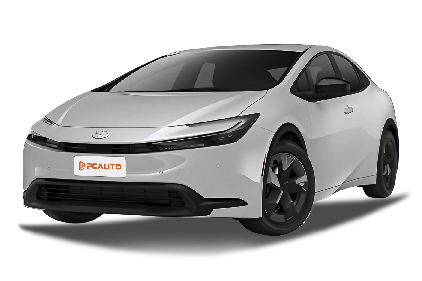Q
Do you have to charge the 2023 Prius?
The 2023 Toyota Prius, as a hybrid model, doesn't need to be externally charged like a pure electric vehicle when used in Malaysia. This is because it automatically charges the battery through the kinetic energy recovery system during vehicle operation and the engine's running. This design is highly suitable for Malaysia's driving environment, especially in congested urban traffic, where it can fully demonstrate its energy-saving advantages.
It's worth mentioning that the 2023 Prius actually offers a plug-in hybrid version (Prius Prime). If you choose this version, you need to externally charge it regularly to get a longer pure-electric driving range (about 70 kilometers). This is very practical for daily short-distance commuting and can further reduce fuel consumption.
The Malaysian government currently offers certain tax incentives for hybrid and electric vehicles. So, both the regular hybrid and plug-in hybrid versions are worth considering. Hybrid technology performs stably in tropical climates, and the battery cooling system has been optimized, making it suitable for Malaysia's hot and rainy climate conditions.
If you often drive long distances, the regular hybrid version will be more convenient. However, if you mainly drive in the city and have the conditions for home charging, the plug-in hybrid version will be a more economical and environmentally friendly choice.
Special Disclaimer: This content is published by users and does not represent the views or position of PCauto.
Related Q&A
Q
Can you jump a 2023 Prius?
Yes, the 2023 Toyota Prius can be jump-started to restore power. However, you need to pay attention to some key steps to ensure safety. This vehicle is equipped with a hybrid system. Its 12V auxiliary battery (usually located in the trunk or under the rear seats) is used to start the vehicle's electronic system, not the drive motor. When jump-starting, you first need to find the positive and negative terminals of the 12V battery (some models may have dedicated jump-start points). Use standard jump-start cables to connect to the battery of another vehicle or an external power source. Start the rescue vehicle and maintain its engine speed to charge the battery. Once the Prius dashboard is powered on, you can try to start the car. After the hybrid system starts, it will automatically charge the 12V battery. The hot and humid climate in Malaysia may accelerate battery aging. It is recommended to regularly check the battery status. If the battery frequently runs out of power, it may indicate that the battery life is coming to an end or there is a parasitic discharge problem in the vehicle, and timely maintenance is required. It's worth noting that the 12V battery capacity of hybrid models is usually smaller than that of traditional fuel-powered vehicles. Therefore, they are more susceptible to the impact of long-term parking or leaving the lights on. It is recommended that car owners carry a portable emergency power supply with them to handle unexpected situations.
Q
Is the Prius 2023 self-charging?
Yes, the 2023 Toyota Prius is a "self-charging" Hybrid Electric Vehicle (HEV). It charges its battery through the kinetic energy recovery system during vehicle operation and the engine running, without the need for an external power source to plug in. Specifically, the hybrid system of the Prius converts kinetic energy into electrical energy and stores it in the battery when braking or coasting. Meanwhile, the battery is also charged when the engine is running. Therefore, car owners don't need to charge the vehicle additionally like they do with Plug-in Hybrid Electric Vehicles (PHEVs) or Electric Vehicles (EVs). For users in Malaysia, this design of the Prius is very convenient because the local charging infrastructure may not be as well-developed as in some other countries. The self-charging hybrid vehicle can not only enjoy the energy-saving advantages of electric drive but also avoid the hassle of charging.
In addition, the 2023 Prius performs excellently in terms of fuel economy and emissions, making it very suitable for the urban road conditions in Malaysia, especially in the frequently congested driving environment. It should be noted that although the Prius is a self-charging hybrid vehicle, it cannot travel long distances solely on electricity like a pure electric vehicle. Its electric mode is mainly used for assisting driving and short-distance, low-speed driving.
Q
How big is the fuel tank on a 2023 Prius?
The fuel tank capacity of the 2023 Toyota Prius is approximately 43 liters. This design balances fuel economy while ensuring sufficient driving range, making it suitable for the daily commuting or long-distance driving needs of Malaysian users. As a representative of hybrid models, the Prius can significantly reduce fuel consumption through its efficient gasoline-electric collaborative system. With a 43-liter fuel tank, it can provide a driving range of about 800 to 900 kilometers under combined driving conditions, which is very suitable for the Malaysian consumer group that faces high oil prices and values environmental protection.
It's worth noting that the fuel tanks of hybrid models are usually smaller than those of pure gasoline vehicles because their electric systems share part of the power demand. Car owners can further optimize fuel consumption by reasonably using the EV all-electric mode. For users who often travel across states, it is recommended to plan the charging routes in combination with the Prius' energy monitoring system. Many shopping malls and gas stations in Malaysia are already equipped with charging facilities, which can fully leverage the energy-saving advantages of hybrid vehicles.
Q
How do I charge my 2023 Prius?
The 2023 Toyota Prius in Malaysia is mainly automatically charged through its hybrid system without the need for external charging. The battery will be automatically charged during driving through brake energy recovery and engine operation, so car owners don't need to take any additional actions. If you're driving the Prius Prime plug-in hybrid version, you can charge it via a household power source or a public charging station. When using household charging, make sure the voltage is stable and a dedicated charging cable is equipped. For public charging, it needs to be compatible with the Type 2 interface. It takes about 2 hours to charge the battery to 80%. It is recommended to regularly check the battery status to ensure its efficiency. Due to the hot climate in Malaysia, it's advisable to avoid long-term exposure to the sun to extend the battery life. Hybrid cars are more fuel-efficient when driving at low speeds in the city, which is suitable for the traffic conditions in Malaysia. For more details on charging, you can refer to the owner's manual or consult a Toyota-authorized service center.
Q
What type of gas does a 2023 Prius take?
The 2023 Toyota Prius in Malaysia is recommended to use RON95 unleaded gasoline. This is the fuel type officially recommended by Toyota for this model, which can ensure the efficient operation of the engine and take fuel economy into account. As a hybrid model, the Prius's Atkinson cycle engine has certain requirements for fuel quality. The octane number of RON95 is suitable for its compression ratio design. Meanwhile, RON95 is widely available at gas stations in Malaysia, making it very convenient to use. It's worth noting that although RON97 has a higher octane number, unless the vehicle specifically requires it, using RON97 won't bring any additional performance or fuel-saving advantages. Instead, it will increase the cost of vehicle use. Car owners in Malaysia also need to pay attention to choosing gas stations with a good reputation to ensure fuel quality and avoid engine carbon deposits or oxygen sensor damage caused by poor-quality gasoline. The maintenance of the battery pack of the hybrid system is also very important. Regular maintenance can extend the battery life. In addition, the hot and humid climate in Malaysia places high demands on the heat dissipation of the hybrid system. It is recommended that car owners regularly check the cooling system as required by the manual.
Q
Does the 2023 Prius have a solar roof?
The 2023 Toyota Prius does offer an optional solar roof configuration in some overseas markets. This technology can use the solar panels on the roof to provide auxiliary charging for the hybrid battery. Meanwhile, it supports powering in-vehicle electrical appliances when the car is parked. However, it should be noted that whether the version introduced in the Malaysian market is equipped with this function should be based on the local Toyota official configuration list.
Solar roof technology has been gradually applied in the new-energy vehicle field in recent years. In addition to Toyota, other brands such as Hyundai and Tesla have also introduced similar designs. Its actual performance is greatly affected by sunlight conditions. In a tropical country like Malaysia, it can theoretically play a better role, but the specific charging efficiency also depends on the area of the photovoltaic panels and the technical solution.
It is recommended that consumers interested in this technology can directly consult Malaysian Toyota dealers to obtain detailed local configurations. At the same time, they can also learn about the adaptation technologies of new-energy vehicles from other brands in tropical climates, such as battery cooling systems or high-temperature protection designs. All these can help better maintain electric and hybrid vehicles in Malaysia's hot and humid environment.
Q
Does a Prius 2023 have a transmission?
The 2023 Toyota Prius is indeed equipped with a transmission system. However, it uses Toyota's unique Electronic Continuously Variable Transmission (ECVT), which is fundamentally different from the mechanical gearboxes of traditional fuel-powered vehicles. The ECVT achieves power distribution through the coordinated operation of the electric motor and the planetary gear set. It doesn't have the fixed gears of a traditional gearbox, so the driving experience is smoother and more efficient. This design is one of the cores of hybrid vehicles, which can intelligently switch between electric-motor drive, engine drive, or hybrid drive modes according to driving conditions, significantly improving fuel economy.
For users in Malaysia, the Prius' ECVT system performs exceptionally well in congested urban roads. It not only reduces the jerks caused by frequent gear-shifting but also lowers fuel consumption through energy recovery. It should be noted that the key points for maintaining a hybrid vehicle lie in the battery pack and the electronic control system. It is recommended to have regular inspections at an authorized service center to ensure the long-term stable operation of the system. Compared with traditional gearboxes, the ECVT has a simpler structure and a lower failure rate. However, if any abnormalities occur, professional technicians with specialized equipment are still required for diagnosis. Other brands, such as Honda's hybrid models, also use similar technologies, but the specific implementation methods have their own characteristics.
Q
Is 2023 Prius AWD or FWD?
The 2023 Toyota Prius is available in two drivetrain versions in the Malaysian market: Front-Wheel Drive (FWD) and All-Wheel Drive (AWD). Consumers can choose according to their needs. The AWD version achieves four-wheel drive functionality through a rear-mounted motor, enhancing stability on slippery roads. On the other hand, the FWD version focuses more on fuel economy. Given Malaysia's rainy climate, the AWD system can improve driving safety in rainy weather. However, the FWD version, with its simple structure and lighter weight, is also highly efficient for daily city driving. As a hybrid model, the drivetrain choice of the Prius doesn't affect its low fuel consumption advantage. All models are equipped with a 2.0L hybrid system, with a significantly improved combined power output while maintaining the reliability that Toyota hybrids are known for. When Malaysian consumers are choosing a car, they can weigh the road conditions and their budgets. If they often encounter rough roads or travel in rainy days, the AWD version is more practical. If their driving is mainly for city commuting, the FWD version offers better cost - effectiveness. Additionally, the 2023 Prius has also been upgraded in terms of chassis and design, with a lower drag coefficient, more appealing handling, and a better - looking exterior, making it suitable for local users who value environmental protection and technology.
Q
Does the 2023 Prius have four doors?
In 2023, the Toyota Prius indeed features a four-door design, continuing its positioning as a practical hybrid family car. The five-seat layout and the structure that facilitates rear-seat passengers getting on and off are highly suitable for the daily use of Malaysian families or urban commuting. This fifth-generation model is built on the TNGA-C platform. The car body is lower and the wheelbase is longer. The opening angle of the rear door reaches 80 degrees, which is relatively large in its class, making it convenient to install child safety seats or carry items.
It's worth mentioning that the 2023 Prius offers two hybrid system options, 1.8L and 2.0L, in the Malaysian market. The 2.0L version has a combined power of up to 193 horsepower, being the most powerful performance version in all generations, while maintaining excellent fuel economy. The vehicle is also equipped with the latest Toyota Safety Sense system, including a pre-collision system and full-speed range adaptive cruise control, which is particularly suitable for the complex urban road conditions in Malaysia.
As the world's best-selling hybrid model, the battery stability of the Prius in tropical climates has also been specially optimized. Malaysian car owners don't need to worry about the impact of high temperatures on the hybrid system.
Q
Does the 2023 Prius have heated seats?
In 2023, the Toyota Prius does come with front heated seats in some high-end models. However, this configuration usually depends on the specific market version and optional packages. In the Malaysian market, due to the hot climate, heated seats may not be offered as a standard feature. It is recommended that you directly consult the local Toyota dealership to confirm the configuration list of the specific model. Considering the climatic characteristics of Malaysia, the seat ventilation function might actually be more practical than heated seats, as it can effectively enhance the seating comfort in hot weather. Currently, some high-end models have started to be equipped with this function.
In addition, as the fifth-generation model, the 2023 Prius is not only about the seat configuration. It is also equipped with Toyota's latest hybrid system, which boasts excellent fuel economy. Meanwhile, it adopts a more sporty design language and more advanced safety technologies, including the Toyota Safety Sense 3.0 system. These are all notable upgrade highlights worthy of attention.
Popular Cars
Model Year
Car Compare
Car Photo
Latest Q&A
Q
Why is gasoline a fuel?
Gasoline can serve as a fuel because it possesses core properties suitable for providing power and the ability to convert energy. It is a hydrocarbon mixture obtained through fractional distillation and cracking of petroleum, mainly containing C5-C12 aliphatic hydrocarbons, naphthenes, and a small amount of aromatic hydrocarbons. It is characterized by volatility and flammability, with low viscosity facilitating smooth flow in injection systems, and rapid evaporation enabling quick formation of a uniform combustible mixture with air. Gasoline stores chemical energy; when ignited by a spark plug in the engine combustion chamber, it burns rapidly to release a large amount of thermal energy, which pushes the piston to move and converts into mechanical energy, providing power for vehicles such as cars and motorcycles. In addition, the anti-knock property of gasoline (measured by octane number) can adapt to engines with different compression ratios, ensuring stable operation and performance; it has a high energy density, storing more energy per unit volume, good combustion efficiency, and high availability of gas stations for convenient use. Therefore, it has become the main fuel for spark-ignition internal combustion engines and is widely used in transportation and related fields.
Q
What are 1st, 2nd, and 3rd family gases?
The first, second, and third family cars are vehicle categories classified based on the stages of family car-purchasing needs. The first family car is an entry-level economical model, such as the Perodua Axia and Proton Saga, priced at approximately 30,000 to 50,000 Malaysian ringgit. It emphasizes fuel efficiency and practicality, making it suitable for young families purchasing a car for the first time. The second family car falls into the mid-range category, offering more space and enhanced features, such as the Proton Persona and Toyota Vios, priced between 60,000 and 100,000 Malaysian ringgit, catering to the comfort requirements of growing families. The third family car is a premium model or an MPV/SUV, such as the Proton Exora and Honda CR-V, priced above 100,000 Malaysian ringgit. It boasts spacious interiors and upscale configurations, ideal for larger families or long-distance travel. Malaysian consumers typically prioritize fuel efficiency, maintenance costs, and space when selecting a vehicle. Families at different life stages adjust their car choices accordingly. For instance, small families may begin with the first category, upgrade to the second after having children, and larger families often opt for the third category.
Q
What are the four types of natural gas?
Natural gas can be classified into four main types based on its source: gas field gas (pure natural gas), associated petroleum gas, condensate field gas, and coalbed methane. Gas field gas is directly extracted from gas wells, typically containing over 90% methane with minimal impurities. Associated petroleum gas is a byproduct of oil extraction, containing not only methane but also significant amounts of other hydrocarbons such as ethane and propane. Condensate field gas yields light hydrocarbon fractions during extraction, characterized by a high methane content and small quantities of heavier hydrocarbons like pentane. Coalbed methane is extracted from underground coal seams, primarily consisting of methane and nitrogen, and must have a methane content exceeding 40% to be utilized as fuel. Due to compositional differences, these natural gas types vary in calorific value and applications. The first three are commonly used for urban gas supply, whereas coalbed methane requires purification before effective utilization. As a clean and efficient energy source, the development and utilization of these diverse natural gas types play a crucial role in optimizing energy structure.
Q
What are the three types of fuel gas?
Common fuel gases are mainly divided into three types: natural gas, liquefied petroleum gas (LPG), and manufactured gas. Natural gas is a flammable gas existing in nature, with methane as its main component. It is colorless and odorless, leaves no residue after combustion, and has high thermal efficiency, making it a clean energy source. Liquefied petroleum gas is a by-product of the petroleum refining process, whose main components include propane and butane. It is a gas at room temperature but can be converted into liquid through pressurization and cooling, facilitating storage and transportation. Manufactured gas is generated through thermochemical reactions of fossil fuels such as coal or petroleum under specific conditions, with main components including hydrogen, carbon monoxide, and methane. It has low production costs but produces certain pollution after combustion, so ventilation should be ensured during use. These three fuel gases have different application scenarios in the energy supply field, and their calorific values and usage characteristics also vary. For example, the calorific value of natural gas is approximately 33,000-36,000 kcal per cubic meter, that of LPG is about 90,000 kcal per kilogram, and that of manufactured gas is roughly 3,500-4,200 kcal per cubic meter. The different calorific values make them suitable for different energy demand scenarios such as households and industries.
Q
Is unleaded petrol a gas?
Unleaded gasoline is not a gas but a liquid fuel. It refers to gasoline with a lead content of less than 0.013 grams per liter and without the addition of tetraethyl lead as an anti-knock additive during the refining process. Its octane rating is typically 95, slightly lower than the 97 of leaded gasoline. The use of unleaded gasoline can effectively reduce emissions of harmful substances such as hydrocarbons, carbon monoxide, and nitrogen oxides in vehicle exhaust, thereby lowering pollution risks including smog, toxic gases, and acid rain. However, it should be noted that while unleaded gasoline contains no artificially added lead, it still retains trace amounts of lead from crude oil. Additionally, its combustion releases gases, particulate matter, and condensates, with particles smaller than 2 microns in diameter being particularly prone to prolonged suspension in the air and subsequent human inhalation. Thus, potential health impacts remain a concern. Currently, most vehicles can use unleaded gasoline directly, though certain models require selecting the appropriate octane grade as recommended by the manufacturer to ensure optimal engine performance and longevity.
View MoreRelated News

The new Toyota Corolla is launched in China, with a wheelbase extended to 2750mm
AshleyDec 23, 2025

Will the Toyota Yaris Cross come to Malaysia? If it comes, how much will it sell for?
JamesDec 19, 2025

2026 Toyota HiLux receives five-star ANCAP safety rating in ANCAP
MichaelDec 12, 2025

2026 Toyota bZ4X features a larger battery and longer range but needs to be sold at a lower price
WilliamDec 12, 2025

Toyota introduces Wolfspeed SiC power semiconductors, considering their durability to be better
JohnDec 11, 2025
View More


















Pros
Cons